SAR note: This is a guest post. If you want to write an article for this site just contact me (Andrea) at sonyalpharumors@gmail.com. Thanks!
—-
An Introduction to the Alpha Mount by Kelly Davis (http://www.kellydavisphotography.com).
Foreword
About five years ago, when I first got into photography, I asked a wedding photographer for some advice on where to begin. She told me to get a DSLR made by Canon or Nikon. I looked down at the a700 in my hands and wondered, “What can’t I do with what I already have?” Consider, for a moment, two of the most famous photos shot in the past fifty years.

Street execution of a Viet Cong prisoner, Saigon, 1968 by Eddie Adams

Afghan Girl by Steve McCurry
The first is a perfect example of being the right place at the right time with a functional camera. The other is a well-composed, well-exposed portrait of an interesting subject, shot by a photographer who understands how to make use of such things. What does the brand of the cameras involved have to do with the greatness of these shots? Nothing. Nothing at all.
History
To understand Sony’s DSLR line, you need to know a bit about Minolta. Minolta was one of the major players in the SLR market for a very, very long time. They never had the market penetration of Canon or Nikon, but they had a reputation for good image quality and ease of use. They were the first to market with an autofocus SLR line. They color-matched their lenses against each other so that photographers could feel confident that their shots would look consistent if they switched lenses halfway through a roll of film. They came out with their first DSLR in 1995. Their Dimage enthusiast point-and-shoot line included manual controls, image stabilization, and a flip-out rear LCD in 2003. Unfortunately, a major lawsuit from Honeywell and declining marketshare took the wind (money) out of Minolta’s sails, which led to their acquisition by Konica. The brand struggled on under the name Konica-Minolta and was eventually sold to Sony.
You can say a lot of things about Sony, and most of them are true. But at the end of the day, they’re a business and they do a lot of research into what “the market” wants. Their early DSLRs fell into two categories:
- Cameras meant to appeal to the entry-level consumer doing side-by-side comparisons in a store (“Brand X has 12 megapixels and takes four photos per second, but the Sony has 13 megapixels and takes five photos per second! The Sony must be better!”).
- Higher-end bodies that functioned much like a film SLR with a digital back. They lacked bells and whistles, but were simple, intuitive, and very well built. They only did one thing – that is, take pictures – but they did it really, really well.
Though successful by any reasonable metric, Sony was unable to pull ahead of Canon or Nikon. Side-by-side comparisons of features don’t mean much if stores don’t carry your products, and the high-end equipment wasn’t adopted by pros in large numbers. Sony realized they needed to do more to differentiate their product line. They did away with the traditional pentaprism/pentamirror design, and replaced it with technology they call SLT.
What is SLT?
Single Lens Translucent, which is a hybrid of Single Lens Reflex and mirrorless technology. As a quick refresher, here’s how SLRs and mirrorless cameras work:

Let’s start with the DSLR. When you look through the viewfinder, you see light that travelled through the lens, bounced off a mirror, reflected up into another mirror (or a prism), and out the eyepiece to you. When you press the trigger, the first mirror pivots upward. This allows the light to hit the sensor, capturing the photo itself. Once the capture is complete, the pivoting mirror rotates back down. It’s a proven technology, but not a perfect one. Nice pentaprism viewfinders are bulky and expensive, whereas cheap penatmirrors tend to be small, dim things that cut off the edges of your shot. During exposure, your autofocus sensors have nothing to focus on, so you can lose track of moving subjects. Without that autofocus sensor, video on a DSLR can be tricky. Finally, think about the mechanical precision needed to make a tiny mirror slap back and forth instantly, several times a second, while staying in sync with other tiny moving parts. Then think about the quality of most consumer electronics. How fast can they really move? And how long will they really last?
The mirrorless camera is much simpler mechanically – no pivoting mirror, no optical viewfinder. The sensor provides a constant live-view mode to the rear LCD or an electronic viewfinder. This allows for a smaller, lighter camera with fewer moving parts. With no mirror, you eliminate the potential of mirror-shake ruining long-exposure shots (as well as eliminating the need for a mirror lock-up mode). Unfortunately, you also lose out on the faster, more accurate autofocus sensors built into DSLRs. You’re also limited by the quality of your output display – it’s hard to compose a shot, or judge image quality, if you’re stuck with a crummy screen to view it on.
SLT is Sony’s way of blending both technologies.
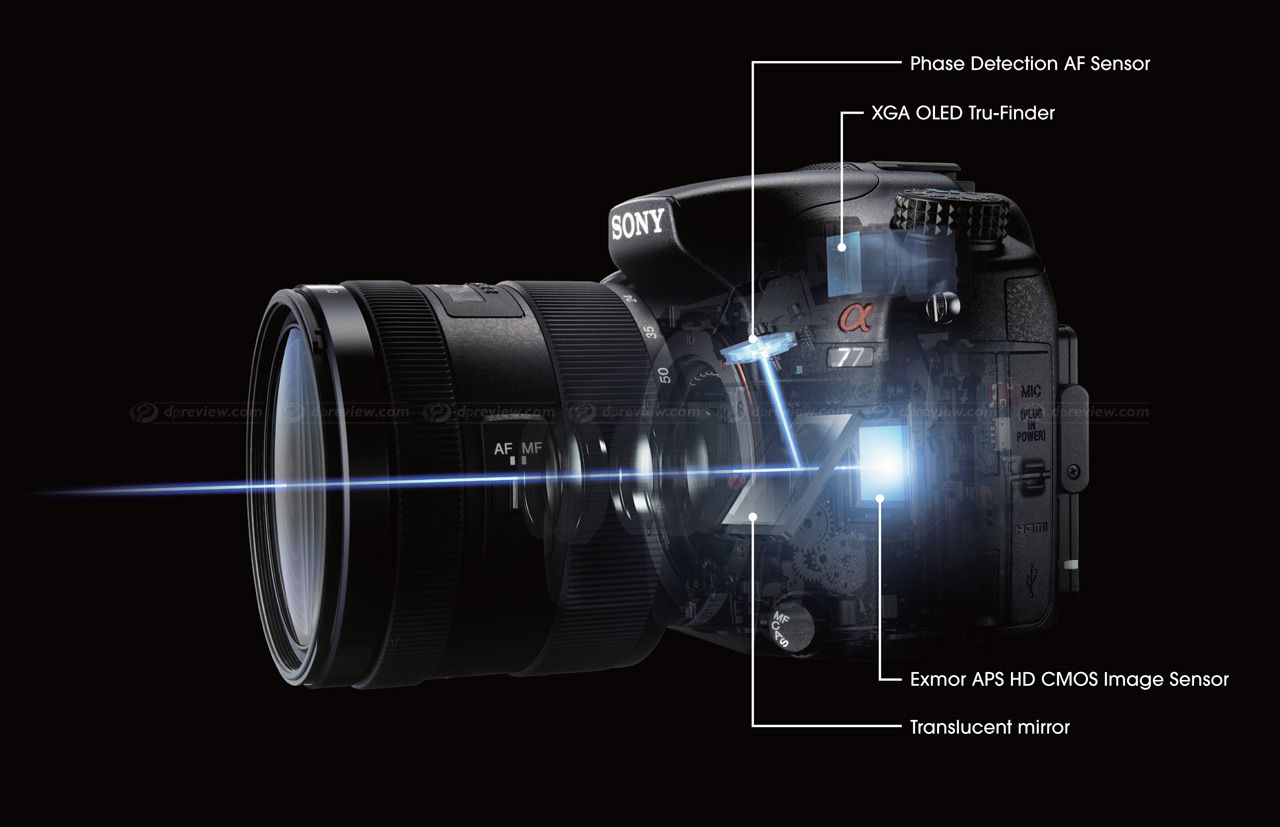
There’s still a mirror involved, but it’s not a normal mirror. It constantly reflects about 1/3rd of the light onto an autofocus sensor, while the other 2/3rds of the light travels through the mirror to the sensor. The sensor then powers an electronic viewfinder. This lets Sony pull off some neat tricks:
- With fewer moving parts, Sony’s burst-shooting modes are some of the fastest on the market.
- By constantly exposing the autofocus sensor, SLTs can more easily track moving subjects during burst shooting and video recording.
- Entry-level bodies are no longer limited to small, dark viewfinders. Though there’s a bit of pixilation, Sony’s electronic viewfinders are much larger and brighter than the viewfinders on comparable bodies from other brands.
- Since the viewfinder is an LCD screen, they aren’t limited to just displaying what the camera can see. Focus peaking is a killer feature which highlights the parts of the image that are in focus, which makes manual focus a breeze. Combine that with the fact that you can adapt m42 lenses to Sony cameras, and you have a whole new world of cheap, easy-to-use lenses.
Of course, nothing is perfect, and SLT technology is no exception. If 1/3rd of the light is constantly reflected onto an autofocus sensor, that means there is 1/3rd less light for your image. It’s no big deal in normally lit situations, but other brands will have an edge in dimly-lit bars and at concerts. In addition, the dynamic range of electronic viewfinders is less than perfect; again, normal lighting is fine, but you may have trouble accurately judging your exposure if your shot has a lot of highlights and shadow.
General Perks of the Alpha Mount
You don’t have to buy a SLT in order to get the most out of a Sony.
- Sony did not change the mount when they bought out Minolta’s DSLR division. Any autofocus Minolta lens will work on a Sony DSLR. Many of these lenses are dirt cheap, are built like a tank, and work flawlessly despite being almost thirty years old.
- Minolta was big on color reproduction, and Sony has maintained that standard. Minolta and Sony lenses tend to have lush, nicely-saturated color, making them great for portraits and landscape work.
- All Sony DSLRs/SLTs build image stabilization into the camera bodies. The general rule of thumb is that in-lens solutions are better, but an in-body solution means every lens is stabilized. You can even stabilize m42 lenses with the proper adapter.
- Speaking of, m42 lenses can be adapted to Sony bodies while maintaining infinity focus. That’s right, you too can learn about the magic (crapshoot) of Soviet lenses, or even enjoy some gems. Focus peaking makes these lenses very easy to use.
- Until very recently, the only autofocus Zeiss lenses were found on the Sony mount.
What are some good Sony bodies?
Before I recommend any specific bodies, let me explain the numbering system. When looking at a Sony DSLR/SLT (or even a NEX, though they’re beyond the scope of this thread), look at the first digit. It will tell you how Sony views the camera in terms of other DSLRs from the same generation of technology. Then, count the total number of digits. If it has three digits (like a700), it’s a DSLR. If it has two digits (like a77), it’s a SLT.
- 1*- 4* – These are the true entry-level DSLRs/SLTs. They tend to be bare-bones models that will teach you the basics, but lack the larger bust-shooting capacity and nicer screens of more advanced models.
- 5* – 6* – These are advanced amateur models. They’re still entry-level bodies, but Sony didn’t go out of their way to strip out as many features. Generally speaking, these make for the best starting point for newcomers to the system.
- 7* – Prosumer bodies. They are built much more sturdily than the entry-level bodies, and their dual control wheels make manual shooting much easier.
- 8* – 9* – Full-frame bodies. If you’re a professional or just want to get the best of the best, these are what to look for.
So what should you buy? If you’re brand new to the mount, try to find an a57, an a580, or an a700. The a57 is a recently-discontinued SLT that seems to hit a sweet spot of image quality, features, and usability. The a580 is a couple of years old and was the last DSLR Sony produced. It’s an entry level body, but it used the same sensor as the Nikon D7000 and Pentax K-5 – meaning it’s one of the few Sony bodies with excellent low-light image quality. Finally, the a700 is an older prosumer body. It was a contemporary to the Canon 50D and Nikon D90. Don’t expect a lot of frills with the camera. There is no articulating screen. No live view. No video. What you get is a very sturdy DSLR with great ergonomics, an interface that takes about thirty seconds to learn, and all it does it take pictures.
Now, if you’re made of money, we can talk about full-frame options. Sony has three full-frame bodies – the a850, the a900, and the a99. The a900 is basically an a700 with a gigantic viewfinder, a larger sensor, and (I believe) an even sturdier build. Though they aren’t officially weather sealed, Antarctica is no big deal to an a900. So, if you found yourself smiling and nodding as I described the a700, and you have the cash for it, go for it – you can find them on eBay for $1500ish. If that’s a bit too rich for your blood, get an a850 – it’s an a900 with an oh-so-slightly smaller viewfinder and only shoots 3 frames per second, and goes for $1000-$1100. If you’re looking for a portrait or landscape full-frame camera, it’s one of the best deals on the market. Then, there’s the a99.
Oh my god, the a99.
The a99 is the nicest camera I’ve ever used. Sony managed to include everything I’ve liked from previous bodies. The a700/a850/a900 had a very simple interface; the a99 has it. The a850 and a900 have a full-frame sensor; the a99 has one. The a580 had excellent low-light capabilities, where ISO 3200 was not just usable, but no big deal; the a99 laughs at ISO 3200. I can’t think of a single meaningful problem with the a99, except perhaps the fact that the autofocus points could be spread out a little more. It’s an excellent camera, and I have no hesitation in recommending it to anyone – provided, of course, you have the money and the know-how to use it.
What are some bad Sony bodies?
First off, I’ll say what I said in the My First DSLR thread – no one makes a “bad” DSLR anymore. Not Canon, not Nikon, not Pentax, and not Sony. None of the Sony bodies will blow up if you try to use them. All of them are usable up to at least ISO 1600, and will work for 90% of the situations the average person would use them in.
With that out of the way, the a230 is the red-headed stepchild of the Sony lineup. As an entry-level body, it has a lot of features stripped out of it. It has the smallest viewfinder of any Sony DSLR. It’s also several years old at this point. If you’re going to go the used route, I’d encourage you to keep searching – you should be able to find a comparable body (a200, a300, a330) for essentially the same price. In addition, I have trouble recommending the a65. As mentioned above, the a65 is basically an a77’s guts in an entry-level body. Sounds good, right? One of the few problems with the a77 is its sensor. 24 megapixels on a crop-sensor is very dense, and it’s hard to find lenses that can really take advantage of that high resolution. It’s not that your photos will be bad, it’s that they won’t be able to take advantage of the sensor’s full potential – you’ll only really have 18 or 20 megapixels (or whatever) worth of detail. So, unless you have really nice lenses, you’re basically spending extra money for a sensor you can’t take full advantage of, plus a nicer viewfinder. I think you’re better off with an a57 (16 megapixels versus 24) or an a77 (a65 with a sturdier build, better rear LCD, and dual-control wheels).
Any Sony/Minolta terminology I should know about?
- Alpha / a – The original name of the Minolta AF mount in Japan, and the current name of the Sony DSLR/SLT system.
- APO – Some Minolta lenses have APO in the title. It means there is an apochromatic element in the lens, which helps reduce chromatic aberrations. Though it’s a bit of a marketing trick, APO lenses tend to have improved image quality over an older, non-APO variant of the same lens.
- D and ADI – Some Minolta lenses have a D in the name. It means they have a distance encoder built into the lens, which helps flashes operate in ADI mode – a variant of TTL metering that tries to take the distance from the subject into account when judging an exposure. Distance encoding is now so commonplace that Sony doesn’t bother marking their lenses with a D. If your lens has nine connection pins on the back and it’s not an xi lens (see below), it’s a D lens.
- DT – Sony’s designation for a crop-sensor lens. These lenses will still work on the a850/a900/a99, as the camera will detect their presence and switch to an 11ish MP crop sensor mode.
- Dynax – The original name of the Minolta AF mount in Europe.
- G – Some Minolta and Sony lenses have the G designation. It’s the Sony equivalent of Canon’s L glass – pro grade stuff.
- HS – High Speed focus gearing. You’ll find this on some higher-end Minolta lenses.
- Maxxum – The original name of the Minolta AF mount in America.
- RS – Minolta’s way of showing a lens was updated (ReStyled). Sometimes, the refresh was minor – slightly more circular aperture blades, modest tweaks to coatings, nothing you’d notice outside of side-by-side test shots. Other times, RS lenses added meaningful improvements, such as the Minolta 100mm f/2.8 Macro RS gaining a focus hold button and 40% faster focus gearing. Still other times, RS lenses were a step down from their original, trading solid metal and nice optics for plastic barrels and mediocre glass. It’s really a case-by-case thing.
- SAM – Smooth Autofocus Motor. Sony is starting to transition away from screw-driven focus. Lower-end lenses have replaced the screw-driven focus system with a simple motorized unit. It feels slow on some lenses, but works just fine on others.
- Screw drive – Almost all of Minolta’s lenses, and roughly half of the Sony lenses, focus by turning what looks like a flat-headed screw on the lens mount.
- SSM – Super Sonic Motor. It’s the Sony equivalent of Canon’s USM focus motors – fast and accurate, but more expensive (and power hungry) than SAM. You’ll find these on Sony’s high end lenses and on a very small number of Minolta lenses (less than 2000 worldwide, if I had to guess).
- SSS – Super Steady Shot, sometimes just called Steady Shot. Sony’s in-body antishake system.
- STF – Smooth Transition Focus. See Minolta 135mm f/2.8 (T/4.5) STF below.
- xi – Some Minolta lenses have an “xi” in their name. These were part of Minolta’s experiment with motorized zoom mechanisms. The motorized zooms only work on a few specific Minolta film bodies. The lenses can still be zoomed manually, and are still functional in all other ways.
- XX / crossed-x – You know how the Xs in Exxon’s logo cross each other? The original Maxxum logo’s Xs did as well. Exxon was not amused, and Minolta stopped doing it. If you see a lens advertising crossed xs, that means it’s from very early in the production run. It’s a purely cosmetic thing, though it does add some resale value to the lens itself.
- ZA – Shows that it’s a Zeiss lens; a bit redundant, as the lens also has Zeiss in its name and big blue Zeiss badges on the body and cap.
What are some good, cheap lenses that are unique to the mount?
Note the use of “unique”. Obviously, lenses like the Tamron 17-50mm f/2.8 are good, and adapted m42 lenses are a dime a dozen. Those lenses are available, or adaptable, to a multitude of mounts. Here are some goodies that are just for you, the Sony shooter.
- Minolta 24mm f/2.8 – A small, well-built prime with a comparable field-of view to a 35mm on full-format. Good center sharpness at f/2.8. Can be found for $150ish for a bargain-quality model, or $200ish for one in great shape.
- Minolta 28mm f/2.8 The smallest of the Minolta primes, and one of the fastest focusing as well. Though there’s nothing exotic about its aperture or focal length, it costs less than $100, has a faster aperture than a kit zoom, and is a more useful focal length on an APS-C sensor than 50mm.
- Sony 35mm f/1.8 DT Of all of Sony’s lenses currently in production, this is the best value for the money. Sharp wide open, great color and saturation, and a useful focal length for both portraits and walkaround use. If you’re only going to buy one lens, this is it. You can find copies for $200ish. Its two main weaknesses are cheap build quality (lots of plastic) and the fact that it is a DT lens; if either bother you, upgrade to the Minolta 35mm f/2 (see below).
- Minolta 50mm f/1.7 The standard nifty 50 for the mount. Easily found for under $100 / roughly half the price of the Sony 50mm f/1.8 / roughly 1/4th the price of the Sony 50mm f/1.4.
- Minolta 50mm f/2.8 macro – One of the sharpest lenses Minolta ever made. Makes for a nice portrait lens on a crop-sensor camera. You should be able to find a copy for $200ish. There are updated versions that add distance encoding. If you’re eyeing the Sony version, consider the Minolta instead – it’s the same optical formula with some minor whistles and bells added.
- Minolta 100mm f/2.8 macro – I’m tempted to just copy and paste the 50mm f/2.8 macro blurb above, as I can basically say the same things here. One of the sharpest lenses Minolta ever made, still being sold with a Sony badge, and so on. You should be able to find a copy for $300ish.
- Minolta 24-50mm f/4 – Of all of the early Minolta zooms, this may be the best replacement for your kit zoom. The focal length is very useful on an APS-C sensor, the lens is usably sharp wide open, and the color is great. Unlike many of the early Minolta zooms, the minimum focus distance is far more usable – one foot versus three to five feet. Best of all, it’s tiny, comparable in size to a prime lens. If you can find a copy for less than $100, consider picking it up.
- Minolta 28-85mm f/3.5-4.5, 35-70mm f/4, and 35-105mm f/3.5-4.5 – Three of the earliest Minolta zooms. They have a good reputation for nice color and sturdy build, though their minimum focal distance is somewhat long (3-4.5 feet) and they are not terribly wide on an APS-C sensor. That being said, you should have no trouble finding the 35-70 for less than $50, the 28-85 for less than $80, and the 35-105 for less than $120. Also, all of them have a somewhat unusual feature by modern standards – a switch you can flip to enable “macro” mode, which deactivates autofocus and lets you focus even closer. If you’re feeling brave, you can mod these lenses to autofocus in macro mode.
- Minolta 28-135mm f/4-4.5 – This lens was Minolta’s original high-end zoom. It experienced a resurgence in popularity when the a900 was released, as (at the time) this lens was dirt cheap on eBay, yet has the best bang-for-your-buck ratio for a fullframe walkaround zoom. The lens has the nickname “secret handshake,” because the “smart” Sony shooters knew that they should buy this lens instead of modern equivalents. Though the minimal focal distance is somewhat restrictive, the lens covers a useful focal range and has great image quality, even when shot wide open. The corners are actually sharper than the Zeiss 24-70, at 1/6th the cost. On the downside, it has awful flare problems and Minolta never made a lens hood for it, so you’ll need to pick up one of those collapsible rubber hoods from eBay. It is also large, heavy, and (reportedly) fragile due to the complicated design. You can find these on eBay for $300ish, sometimes less.
- Konica Minolta 28-75mm f/2.8 – Once upon a time, Minolta owned a 20% stake in Tamron. During Minolta’s darker days, they relied on this relationship to save money on their R&D costs by rebadging some Tamron lenses as Minoltas. The KM 28-75 is one of those lenses. It’s a rebadged Tamron 28-75mm f/2.8 lens, possibly with different coatings. It has nice center sharpness, good color reproduction, and is another lens that gives the Zeiss 24-70 a run for its money. Think of it as the full-frame equivalent to the Tamron 17-50 f/2.8 – it’s not the greatest lens in the world, but it’s a great lens for the money. You should be able to find a copy for $300ish, maybe $350.
- Sony 55-200 f/4-5.6 DT – Another Tamron rebadge. Normally, for a lens of this focal range, I tell people to buy a Beercan (see below). However, I understand that the Beercan may not be everyone’s thing. This lens is less than half the weight, is about half the length when collapsed, and handles chromatic aberrations much better. It’s one of those lenses that is far nicer than you’d expect given the cost and build quality (lots of plastic). It’s also a little cheaper than the Beercan; a used copy costs $100ish. There’s also a version of this lens with a SAM motor – link. Other than the SAM versus screw drive motor, the two versions of this lens are identical.
- Minolta 70-210mm f/4 “Beercan” – Of all the Minolta lenses, this is the one with the greatest cult following. It’s a big, heavy cannon of a lens. It is about the same size and weight as a tallboy of beer, so that’s where it got the nickname. It is usably sharp wide open, and very sharp at f/5.6. Classic Minolta color, richly saturated with low contrast. Full-frame, so a850/a900/a99 shooters can (and do) use it. It holds up well against the much newer, and much more expensive, Canon 70-200mm f/4. If you aren’t afraid of buying used, and don’t mind the extra size/weight, this lens is a no brainer.
I have money to burn. Tell me about the good stuff that’s unique to the mount.
- Zeiss 24mm f/2, 50mm f/1.4, 85mm f/1.4, and 135mm f/1.8 – Zeiss’s autofocus primes for the mount. Everything you would expect from a Zeiss lens is here – razor-sharp image quality, an all-metal build, and fantastic color reproduction. Zeiss color is different than Minolta color – a little less saturated, a little more green – but it’s very nice, very accurate. If you want the best possible primes for the mount, here you go.
- Minolta 28mm f/2, 35mm f/2, and 100mm f/2 – A trio of high-end primes from Minolta that lack modern counterparts (though the Sony 35mm f/1.8 is a match optically). They’re small, they’re light, they’re sturdy, and they’re sharp wide open. Scarcity and lack of modern equivalents have driven up the cost of these higher than you might expect. The 28mm f/2 goes for around $500 on eBay, and the 35mm f/2 goes for around $600. The 100mm f/2 goes for close to a grand, which seems a little ridiculous, but less so when you consider the cost of 85mm and 135mm lenses with apertures faster than f/2.8.
- Minolta 135mm f/2.8 (T/4.5) STF – Minolta’s attempt at creating a lens with perfect bokeh. It uses a special apodization element that eats up about a stop and a half of light. Between some sort of black magic related to that and a ten-blade, perfectly-circular stepless aperture, you end up with completely smooth bokeh. If bokeh is a big deal to you, this is pretty much the best in class from any mount. As far as I know, it’s also completely unique to the market – no one else makes a lens like this. For reasons I don’t quite understand (related to the black magic element), it only focuses manually, though SLT focus peaking makes this a non-issue. The Minolta version is relatively rare, but Sony still sells their rebadged version of this lens.
- Minolta 200mm f/2.8 APO – As I understand it, the three sharpest Minolta lenses are the 50mm f/2.8 macro, the 100mm f/2.8 macro, and this lens. It’s a big piece of glass, but smaller and sharper than a 70-200mm f/2.8 zoom. If you need 200mm and don’t need to zoom – say, you shoot a lot of events and are used to setting up in the back of dark auditoriums – this is a great lens. You should be able to find a copy for less than $1000. An HS version of this lens exists as well.
- Sony 16-50mm f/2.8 DT SSM – The Sony equivalent of the Tamron 17-50mm f/2.8. It costs more, but you get a slightly wider field of view, fast SSM focusing, a sturdy build, and weather sealing. Sony really nailed the color reproduction with this lens, it’s images are very pretty. Distortion is a bit greater than you’d expect at 16mm, but it’s correctable in post. If you’re willing to buy a Tamron 17-50mm f/2.8 for its new price, consider picking up one of these at used prices instead – for $500-$550 bucks, it’s one of the best DT zooms available for the mount, and a better value than the Zeiss below (which retails new for $999).
- Zeiss 16-80mm f/3.5-4.5 DT – The other “good” crop-sensor zoom. In terms of image quality, it’s pretty much neck-and-neck with the Sony 16-50mm f/2.8. It is smaller and lighter, zooms a bit further, and has a slightly different color cast than the Sony. On the other hand, it is more fragile than the Sony and is not weather sealed. It really comes down to personal preference between these two, but they’re both excellent lenses.
- Minolta 80-200mm f/2.8 HS APO G – In the market for a 70-200mm f/2.8 lens? You can pick the Tamron, which is great optically, but takes forever to rack back and forth between infinity and MFD if it loses focus. You can pick the Sigma, which focuses quickly but is a bit soft wide open. You can pick the Sony, which is the happy medium between the two, but costs $2000. Or, you can go the fourth route and get this lens. This is one of the fastest focusing lenses I’ve ever used. Yes, that includes primes. Its high-speed gearing is so fast that it torques the lens, causing your camera to jerk in your hand a bit. There’s no focus limiter, but it doesn’t really need one – again, stupidly fast focusing. Image quality is great, color is great, and build quality is great. You can find these for $1100-$1200, maybe less if you’re patient. There’s a non-HS version that focuses more slowly, but is just as nice optically – it was made before the G designation existed. It’s black and therefore less conspicuous, and is a little cheaper as well.
- Sony 70-400mm f/4-5.6 SSM G – One of the greatest lenses currently in production by Sony. You know how 55-200 zooms are good, but kind of short? You know how 75-300 zooms are kind of crummy? You know how 70-300 zooms are nice, but still not razor sharp and still don’t have enough reach? This lens fixes all those problems. It’s sharp wide open at any focal length. It focuses quickly enough for wildlife and sports. It has nice color and saturation. Its giant hood has a little trap door built into it so that you can rotate circular polarizers without removing the hood and introducing flare. One way of looking at lenses is by their value for the money. There are a lot of good lenses that, though nice, are hard to justify for the price. For example, I haven’t mentioned the Zeiss 24-70mm f/2.8 SSM in this section. Why? It’s a beautiful lens, but I have a hard time recommending it when the KM 28-75 is almost as good and 1/6th price. I don’t have that problem with the Sony 70-400mm. It’s worth every penny, and nothing else in the lineup touches it.
Special Bonus Section – Lenses that are cheap and good, but only make sense if you’re using an a850/a900/a99
- Konica-Minolta 17-35mm f/2.8-4 D – This is another Tamron rebadge that can be found for $300 or less. This is the cheapest ultrawide zoom available for the mount, and turns in a reasonable performance. The corners at 17mm f/2.8 are crummy, but this isn’t the sort of lens you use like that – you’re supposed to be using it at f/8-f/11 for landscape and architecture shots. While you can certainly use it on a crop sensor camera, you have nicer options for $300.
- Minolta 20mm f/2.8 – A very nice ultrawide prime with an unfortunate design flaw – the lens tends to focus past infinity. You can fix this with some slight manual focus work, and when you do, it’s a real beauty of a lens. Like the KM 17-35, it’s a great full-frame lens for $300, but you’ve got comparable options for much cheaper on a crop sensor (and they won’t have the focal plane drift issue). Unless you really, really want to shoot wide, I think a crop-sensor user will get more mileage out of a Minolta 24/28mm f/2.8 and Sony 35mm f/1.8, for about the same cost.
You’ve described a few lenses as “rebadged”. Is the difference literally just a badge? What lenses are rebadged?
When I describe a lens as “rebadged”, I’m mostly referring to cosmetic changes to the barrel itself. The optical formula is the same – x elements in y groups. There may be some changes to the coatings, particularly if the original design is a Tamron. If there are any other significant changes, I’ll make note of it below – otherwise, assume the lenses are essentially identical. You can save a boatload by buying the older versions of these lenses.
- The Sony 16mm f/2.8 Fisheye is a Minolta 16mm f/2.8 Fisheye.
- The Sony 20mm f/2.8 is a Minolta 20mm f/2.8 RS.
- The Sony 35mm f/1.4 G is a Minolta 35mm f/1.4 G RS.
- The Sony 50mm f/1.4 is a Minolta 50mm f/1.4 RS with distance encoding (D) added.
- The Sony 50mm f/2.8 Macro is a Minolta 50mm f/2.8 Macro D.
- The Sony 100mm f/2.8 Macro is a Minolta 100mm f/2.8 Macro D.
- The Sony 135mm f/2.8 (T/4.5) STF is a Minolta 135mm f/2.8 (T/4.5) STF.
- The Sony 300mm f/2.8 G SSM is a Minolta 300mm f/2.8 APO G D SSM (yeah, lots of extra letters), though the Sony may have an updated SSM motor. The Minolta version is very rare.
- The Sony 500mm f/8 reflex is a Minolta 500mm f/8 reflex. Fun fact – these are the only autofocus reflex lenses ever made by any manufacturer.
- The Sony 11-18mm f/4.5-5.6 DT is a Konica-Minolta 11-18mm f/4.5-5.6 DT D, which in turn is a Tamron SP AF 11-18mm f/4.5-5.6 Di II.
- The Konica-Minolta 17-35mm f/2.8-4 D is a Tamron 17-35mm f/2.8-4.
- The Sony 18-70mm f/3.5-5.6 DT is a Konica-Minolta 18-70mm f/3.5-5.6 DT D. Both versions are meaningfully crummy and should be avoided – I’m just including them here for the sake of completeness.
- The Sony 18-200mm f/3.5-6.3 DT is a Konica-Minolta 18-200mm f/3.5-6.3 DT, which in turn is a Tamron 18-200mm f/3-5-6.3 Di II. Again, included only for the sake of completeness.
- The Sony 18-250mm f/3.5-6.3 DT is a Tamron 18-250mm f/3.5-6.3 Di II.
- The Sony 24-105mm f/3.5-4.5 is a Minolta 24-105mm f/3.5-4.5 D.
- The Sony 28-75mm f/2.8 is probably a Konica-Minolta 28-75mm f/2.8, which in turn is a Tamron 28-75mm f/2.8. Though all three lenses have the same number of elements/groups, the Sony has a slightly different minimum focus distance, as well as a SAM motor.
- The Sony 55-200mm f/4/5.6 DT is a Tamron 55-200mm f/4-5.6. The Sony 55-200mm f/4-5.6 DT SAM shares the same optical design, but adds a SAM motor.
- The Sony 70-200mm F/2.8 G SSM is a Konica-Minolta 70-200mm f/2.8 APO G D SSM, though the Sony may have an updated SSM focus motor. These are also pretty rare – it was the final lens Konica-Minolta released before they were sold to Sony, and fewer than 2,000 were made before the buyout.
- The Sony 75-300mm f/4.5-5.6 is a Minolta 75-300mm f/4.5-5.6 D.
What are some good resources for further reading?
- Dyxum is the greatest English-language source of Sony/Minolta info you’re going to find. Their lens review section is really extensive and excellent, though I find the sharpness values to be a bit inflated. Their forum is active and the forum goers there are helpful, without being fanboys or zealots.
- Kurt Munger runs a small but extensive review site. Though he’s starting to branch out into NEX and m43 gear, his older reviews touch on almost every Minolta/Sony lens you would realistically consider. I really like his reviews because they don’t pixel peep – it’s more real-world sort of stuff. He also proved a little dust on your lens is no big deal.
- Michael Hohner and Pete Ganzel both have excellent collections of Minolta lens technical info. In particular, Pete’s tinkering page has a lot of crazy disassembly and cleaning walkthroughs. If your Minolta lens develops sticky aperture blades, I’d check his tinkering page first to see if he has posted a disassembly guide.
- Photo Club Alpha is a British website/periodical that posts articles about Sony and Minolta lenses from time to time. It’s worth a read, but don’t bother checking on a daily basis or anything – it’s more of a monthly thing.
- Sony Alpha Rumors is a rumor site, so everything they say should be taken with a grain of salt. That being said, they do get leaks of legit info from time to time. If their rumor is rated “SR5”, it’s worth taking seriously.
- Gary Friedman is a former NASA engineer who now writes excellent guides for Sony DSLRs/SLTs, and teaches (brand agnostic) classes on technique. I own two of his books and have no trouble recommending him.
Kelly Davis is a Seattle area wedding and event photographer who believes there is more to good photography than the brand of camera or the price of a lens. This article originally appeared on the Something Awful Forums, which has a nicer photography community than the name might suggest. ☺Kelly Davis[/url] is a Seattle area wedding and event photographer who believes there is more to good photography than the brand of camera or the price of a lens. This article originally appeared on the Something Awful Forums, which has a nicer photography community than the name might suggest. ☺
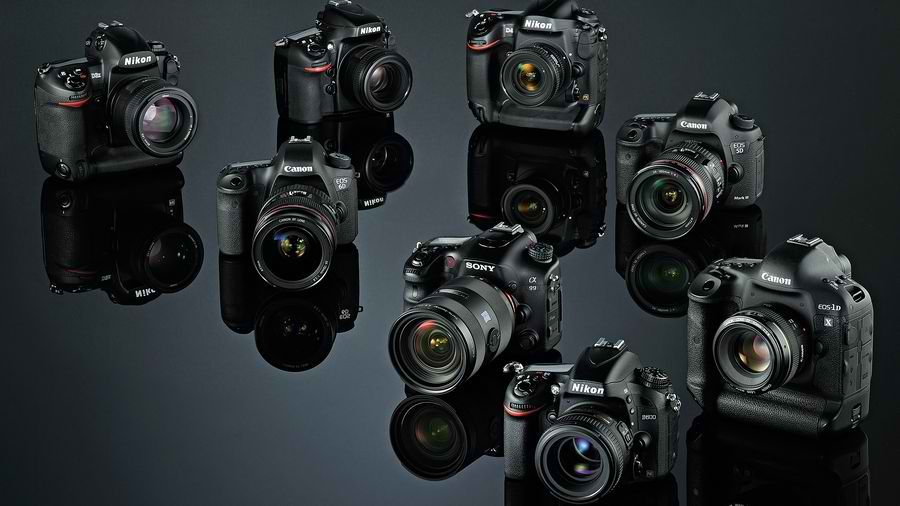
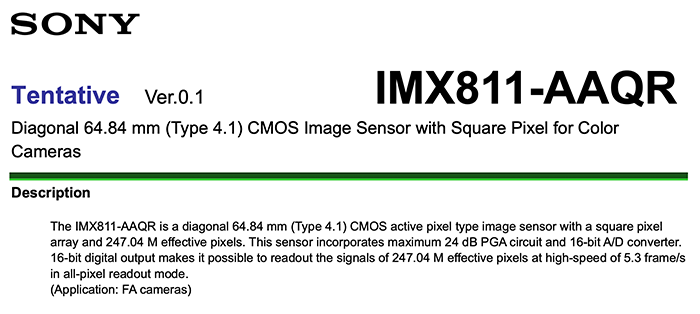
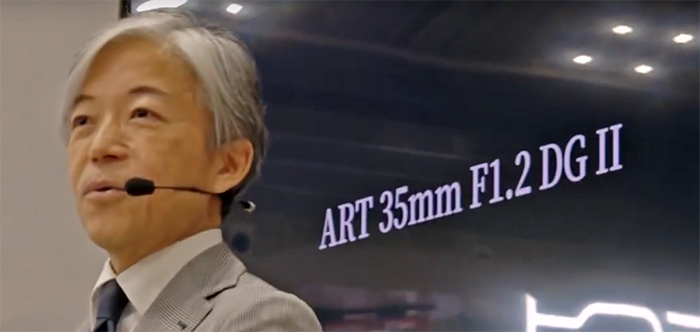

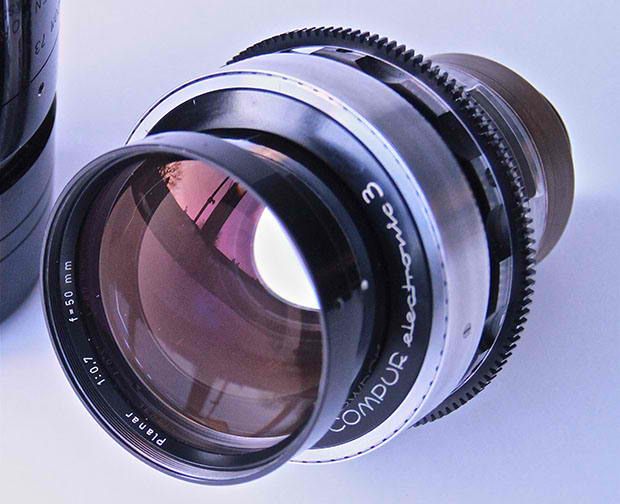
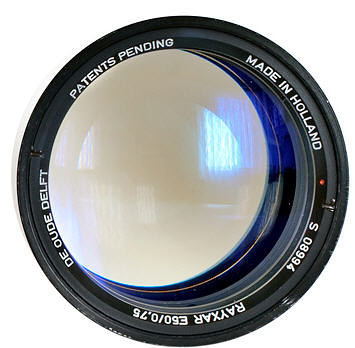 [/shoplink]
[/shoplink]



